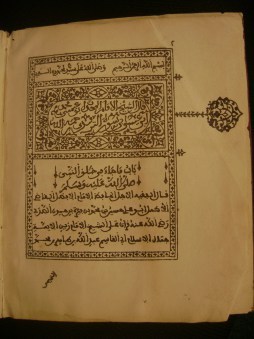PHILADELPHIA--(BUSINESS WIRE)--Penn Libraries recently acquired an extraordinary collection of lithographic books printed in Fez, Morocco, during the latter half of the 19th and the beginning of the 20th centuries. It includes some 108 titles in 136 volumes and represents one of the largest private assemblages of Fez lithographs outside of Morocco. This unique collection, built by Dr. Fawzi Abdulrazak, the leading scholar of the history of printing in Morocco and author of the authoritative bibliography of Fez lithographs, gives Penn Libraries the distinction of owning an exceedingly rare and invaluable resource, and one that few other libraries can match.
“I am very glad to have my collection at Penn Libraries. It is in great hands. I know that it will be carefully preserved, and will be freely available for use by scholars. This is very important to me,” said Dr. Abdulrazak.
The bulk of the collection dates from 1865 to 1936, covering most of the span of Moroccan lithographic printing from its beginning in the city of Fez to its end during the French Protectorate. It is important to note that five of the works included in the collection are the very first lithographic books produced in Fez. In initiating their printing industry, the Moroccans chose the lithographic method over moveable type, because they felt it preserved a link to their country’s rich heritage of manuscript production. As is common in Moroccan manuscripts, five different types of Arabic script were used in making the lithographs, and Penn Libraries’ newly acquired collection reflects this.
Initially, the royal court was the driving force in the printing of the new lithographic books, but soon private firms appeared. The collection includes works made by all of the various printers in Fez. In general, the Moroccan intelligentsia felt that printing would preserve and invigorate their scholarship in the face of French and Spanish challenges by making books, and the knowledge they contained more widely available. The Penn Libraries’ collection includes works by over 101 scholars and editors whose work represents the pinnacle of Muslim scholarship in North Africa during the 19th and the beginning of the 20th centuries. Islamic law and mysticism are the most common subjects; other subjects include Islamic doctrine, religious life, philosophy, Arabic grammar, and rhetoric.
The lithographs were much sought after at the time of their issue due to their first rate materials and printing, their exceptional scholarly worth, and the meticulous editing done to the texts. Their value has increased immeasurably today. They are superb examples of the printer’s art in the Islamic lands, and of the intellectual achievements of Moroccan scholars of the time.
“The Fez Lithograph Collection will offer Penn scholars unparalleled opportunities for study in the fields of the material history of printing in Morocco and the Islamic world as a whole, and of the intellectual history of Morocco during a crucial period in its history,” said David Giovacchini, Middle East Studies Librarian at Penn Libraries.
In addition to the lithographs, the collection includes a number of Arabic manuscripts from Morocco. There are 41 titles in 23 separate items on diverse subjects, ranging in date from the 17th century to the early 20th. In addition, there are also a number of moveable type style books, printed in Morocco under the French Protectorate.
The Fez Lithographs Collection is currently being processed in the Middle East section of the Van Pelt Library, one of fifteen separate libraries at the University of Pennsylvania that serve the humanities, social and physical sciences. After processing, the collection will be permanently housed in the Rare Book and Manuscript Library at Van Pelt. In the fall, Penn Libraries and the Middle East Center at Penn are planning to bring Dr. Abdulrazak to campus to speak about the collection and the history of printing in Morocco.




